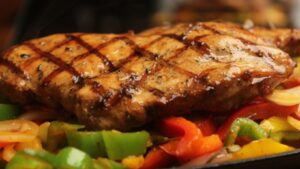The word “schnitzel” in most of German-speaking countries refers to a cutlet of meat, breaded and fried, that is usually served as an appetizer. The word “schnitzel” is believed to have evolved from the German verb “schneiden” (“to cut”) and “schneid” (“a slice” or “a slice of something”).
A classic German dish that is tasty, crunchy and juices all the flavors. If you’re looking for the perfect comfort food, this is it.
Classic German Schnitzel Recipe | Create the perfect plate of food for your friends and family to enjoy. This German classic is one of our favorite foods to make at home. (Ingredients)

An Authentic German Schnitzel Recipe That Is Sure To Please!
If you’re looking for a traditional German meat meal, German Schnitzel is a wonderful choice!
This pork schnitzel recipe uses finely pounded meat to produce beautiful golden brown schnitzel every time.
Pork schnitzel, garnished with a slice of lemon, goes well with potato dishes like French fries or German potato salads!

Recipe Tips & Substitutions
Just a heads up: this is a German schnitzel recipe, not a Wiener schnitzel recipe. True wiener schnitzel is prepared using veal, while German schnitzel is typically made with pig.
However, since the methods of preparation are almost same, you may substitute veal and still follow the steps described in the recipe card below!
Follow these recipe guidelines for the best results while making schnitzel:
Make careful you use the flat side of the meat hammer while pressing the pork cutlet. The pointy side is used to tenderize the schnitzel, but it may damage it and cause holes!
To make breading the schnitzel easier, try to drip off as much egg wash as possible. Excess egg will also cook differently in the frying pan, perhaps ruining the beautiful brown outside!

When frying, be sure to use lard, shortening, or a high-smoke-point oil (such as avocado oil). Butter burns at an alarming rate.
Patience is a valuable asset. When frying German schnitzel on low, you can guarantee an equal golden crust and avoid excessively burned areas.
Step-by-Step Instructions for Making German Schnitzel
You may follow the recipe card at the bottom of this article for precise measurements and a complete list of ingredients to create this traditional schnitzel dish at home.
Follow the recipe process pictures in this section if you want to see what each step looks like.
You may compare your schnitzel progress to ours and see whether you’re on the right road this way!

To begin, gather three big plates with a slight edge and place them on your desk.
On the first plate, pour the flour. On the second plate, crack the eggs and whisk them with a fork until they are uniform in color. Finally, on the third dish, sprinkle the breadcrumbs.

If there is any extra fat on the meat, trim it away.

Using the flat side of a meat hammer, pound one pork chop between two sheets of cling wrap (or in a freezer bag) until thin.

You’ll be amazed at how big even tiny bits of flesh can grow. At the same time, take care not to pound holes in your flesh.

Season both sides of the pork chop with salt and pepper, then put it aside while you finish the rest of the meat.

After all of the meat has been pounded and salted/pepped, it’s time to cover it with breadcrumbs.
To begin, put one pounded pork chop on the floured plate and gently push down. Turn it over so that the opposite side receives some flour as well.

Then pull it up and put the meat on top of the whisked eggs on a platter. Flip it over so that the opposite side is also covered.

Lift the piece of meat, allowing the excess egg to drop off, and place it on a dish with the breadcrumbs.
Slightly push down, then flip it over and press down again. Make sure the meat is completely coated with breadcrumbs.
Then transfer the breaded meat to a separate dish. With the remaining meat, repeat the flour-egg-breadcrumb procedure.

In a large frying pan, heat the oil, lard, or shortening.
Place a wooden spoon into the oil to see whether it is hot enough. It’s hot enough when tiny bubbles start to form around the spoon.

Place the meat chunks in the pan now. You may need to do this in two or more rounds, depending on the size of your pan and the amount of the meat.

Cook the meat for 3-4 minutes over medium heat before gently flipping it over without breaking the breadcrumb layer.
We use tongs, but if you’re cautious, you can use a flipper. Fry for 3-4 minutes more, or until completely done.

Then remove the Schnitzel to a platter and continue to cook the remaining meat.

Lemon slices or wedges should be served with the Schnitzel. Classic French fries, German fried potatoes, and potato salad are all popular schnitzel side dishes.
This schnitzel recipe may also be used to create a wonderful Schnitzel sandwich or schnitzel for Jägerschnitzel (schnitzel with a creamy mushroom sauce)!
Storage Suggestions
In our view, the greatest way to enjoy schnitzel is to eat it straight out of the pan. Leftovers may be stored in the fridge in a sealed bag, sealed container, or on a plate with cling wrap.
Any leftovers should be consumed within 1-2 days.
The microwave is the most convenient way to reheat these Schnitzel, but you may also warm them on a baking sheet in the oven.
Many people like to eat their schnitzel cold since it is quicker, simpler, and more tasty!
FAQ
What exactly is Schnitzel?
Schnitzel is breaded and pan-fried thinly pounded meat, typically pig or veal.
What is the difference between German and Austrian schnitzel?
The kind of meat utilized makes a difference. A traditional German schnitzel is prepared with thinly pounded pork, while a genuine Wiener Schnitzel is created with thinly pounded veal.
What should I serve with German or Wiener Schnitzel?
French fries, fried potatoes, and a variety of potato salads may all be served with German (pork) Schnitzel. The same potato-based sides may be served with Wiener Schnitzel. Wiener Schnitzel is often served with a vinegar-based potato salad in Vienna.
Recipes that are similar
Here are some favorites to try for more excellent German beef recipes:
Ingredients
- 4 pork chops (boneless) (see notes)
- season with salt to taste
- salt and pepper to taste
- a quarter cup of flour
- 2 eggs, big
- 2/3 cup unseasoned breadcrumbs
- a third of a cup of fat, shortening, or oil
- decorating with a lemon
Instructions
- To begin, gather three big plates with raised sides for your workspace. On the first plate, put the flour; on the second dish, break the eggs and whisk them with a fork until they are uniform in color; and on the third plate, put the breadcrumbs.
- Trim away any extra fat from the meat.
- Using the flat side of a meat hammer, pound one pork chop between two sheets of cling wrap (or in a freezer bag) until thin. You’ll be amazed at how big even tiny chunks of meat can get. At the same time, use caution since you don’t want to pound holes in your flesh.
- Season the pork chop on both sides with salt and pepper, then put it aside. Pound the remaining meat and season it with salt and pepper.
- Take one piece of meat and put it on the floured plate, pressing down slightly. Turn it over so that the opposite side receives some flour as well. Lift it up and put it on top of the whisked eggs on the dish. Flip it over so that the opposite side is also covered. Lift the piece of meat, allowing the excess egg to drop off, and place it on a dish with the breadcrumbs. Slightly push down, then flip it over and press down again. Make sure the meat is completely coated with breadcrumbs. Then transfer the breaded meat to a separate dish. With the remaining meat, repeat the flour-egg-breadcrumb procedure.
- In a large frying pan, heat the oil, lard, or shortening. Place the chunks of beef into the pan after the oil is heated enough (test by putting a wooden spoon into the oil; if tiny bubbles form around the spoon, it is hot enough). You may need to do this in two or more rounds, depending on the size of your pan and the amount of the meat. Cook the meat for 3-4 minutes over medium heat before gently flipping it over without breaking the breadcrumb layer. We use tongs, but if you’re cautious, you can use a flipper. Fry for 3-4 minutes more, or until completely done. After that, place the Schnitzel on a platter.
- Lemon slices should be served with the Schnitzel. Classic French fries, German fried potatoes, and potato salad are all popular side dishes.
Notes
- Veal cutlets may be used instead of pig cutlets. You may name your Schnitzel a “Wiener Schnitzel” if you use veal (Vienesse Schnitzel). If you use pork, the Schnitzel can only be termed “Schnitzel Wiener Art” (Schnitzel Vienesse Style) – but the flavor will be just as good if you pound the flesh very thin.
- Due to its low smoke point, we do not suggest frying the Schnitzel in regular butter. If you use lard, vegetable shortening, or a high-smoke-point oil, it’ll be a lot simpler (e.g. avocado oil).
- Leftovers may be kept in the fridge in a sealed container. They should be consumed within 1-2 days.
Information about nutrition:
Serving Size: 4 1 Serving Size: 1 Serving Size: 1 Serving Size: 1 Serving Size: 1 Serving Size: 1 Serving Size 669 calories 46 g total fat 16g Saturated Fat 0g trans fat 28g of unsaturated fat 214 milligrams of cholesterol 432 mg sodium 21g carbohydrate 2 g fiber 2 g sugar 43 g protein
An online nutrition calculator was used to determine this nutritional information. It should only be used as a guideline and not as a substitute for expert dietary guidance. Depending on the particular components used, the exact values may vary.
How did this recipe turn out for you?
You may save it to one of your Pinterest boards and come back to it at any time!
Schnitzel is a German meat pie that has become a popular dish with millions of fans around the globe. The dish originates from the Northern Germany town of Kiel, where fried breaded fillets of pork (or veal) are traditionally served in a slightly sweet broth with a side of potato dumplings. When travelling to Germany, many travellers get interested to try this delicious and traditional dish and it is not difficult to find someone who can help you. Indeed, in Kiel, Schnitzel Kneipe will gladly serve you this meal and you will experience a traditional German meal made with love and passion.. Read more about what to serve with schnitzel and let us know what you think.
Frequently Asked Questions
What is traditionally served with Wiener Schnitzel?
Wiener Schnitzel is traditionally served with either mashed potatoes, or potato salad.
What cut of meat is used for schnitzel?
Schnitzel is a German dish that consists of a thin breaded and deep-fried veal, pork or chicken cutlet.
What is the difference between Jaeger schnitzel and wiener schnitzel?
Jaeger schnitzel is a type of German meat dish, while wiener schnitzel is a type of Austrian meat dish.




